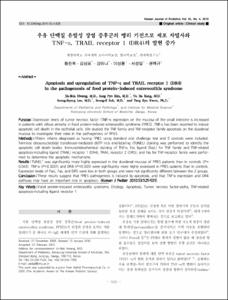우유 단백질 유발성 장염 증후군의 병리 기전으로 세포 자멸사와 TNF-α, TRAIL receptor 1 (DR4)의 발현 증가
- Keimyung Author(s)
- Hwang, Jin Bok; Kim, Sang Pyo; Kang, Yu Na; Lee, Seong Ryong; Suh, Seong Il; Kwon, Taeg Kyu
- Department
- Dept. of Pediatrics (소아청소년학)
Dept. of Pathology (병리학)
Dept. of Pharmacology (약리학)
Dept. of Microbiology (미생물학)
Dept. of Immunology (면역학)
Institute for Medical Science (의과학연구소)
- Journal Title
- Korean Journal of Pediatrics
- Issued Date
- 2010
- Volume
- 53
- Issue
- 4
- Keyword
- Food protein-induced enterocolitis syndrome; Etiology; Apoptosis; Tumor necrosis factor-alpha; TNF-related apoptosis-including ligand receptor 1
- Abstract
- Purpose : Expression levels of tumor necrosis factor (TNF)-α expression on the mucosa of the small intestine is increased in patients with villous atrophy in food protein-induced enterocolitis syndrome (FPIES). TNF-α has been reported to induce apoptotic cell death in the epithelial cells. We studied the TNF family and TNF-receptor family apoptosis on the duodenal mucosa to investigate their roles in the pathogenesis of FPIES. Methods : Fifteen infants diagnosed as having FPIES using standard oral challenge test and 5 controls were included. Terminal deoxynucleotidyl transferase-mediated dUTP nick end-labeling (TUNEL) staining was performed to identify the apoptotic cell death bodies. Immunohistochemical staining of TNF-α, Fas ligand (FasL) for TNF family and TNF-related apoptosis-including ligand (TRAIL) receptor 1 (DR4), TRAIL receptor 2 (DR5), and Fas for TNF-receptor family were performed to determine the apoptotic mechanisms. Results : TUNEL+ was significantly more highly expressed in the duodenal mucosa of FPIES patients than in controls (P = 0.043). TNF-α (P =0.0001) and DR4 (P =0.003) were significantly more highly expressed in FPIES patients than in controls. Expression levels of FasL, Fas, and DR5 were low in both groups and were not significantly different between the 2 groups. Conclusion : These results suggest that FPIES pathogenesis is induced by apoptosis, and that TNF-α expression and DR4 pathway may have an important role in apoptosis.
목 적 : 융모 위축을 보이는 FPIES 환자의 소장 점막에는 TNF-α의 발현이 증가한다. TNF-α는 상피 세포의 세포 자렴사를 유발하는 것으로 알려져 있다. 저자들은 FPIES 병리생리의 특성을 알아 보고자 십이지장 점막 조직에서 TNF family와 TNF-수용체 family의 세포 자멸사를 연구하였다. 방 법 : 표준화된 경구 유발 시험을 통하여 FPIES로 진단된 15례의 환자와 5례의 대조군을 대상으로 연구하였다. 세포 자멸사를 확인하기 위하여 terminal deoxynucleotidyl transferase-me-diated dUTP nick end-labeling (TUNEL) 염색을 시행하였다. 세포 자멸의 기전을 알아 보기 위해 TNF family의 TNF-α, Fas ligand (FasL)와 TNF-수용체 family의 TNF-related apoptosis-including ligand (TRAIL) receptor 1 (DR4), TRAIL receptor 2 (DR5), Fas를 면역조직화학으로 염색하였다. 결 과 : TUNEL+ 세포는 대조군에 비하여 FPIES 환자군의 십이지장 점막에서 의미 있게 높게 발현하였다(P =0.043). TNF- α (P=0.0001)와 DR4 (P =0.003)도 대조군에 비하여 FPIES군에서 의미 있게 높게 발현하였다. FasL, Fas, DR5의 발현은 두 군 모두에서 낮았으며, 두 군간에 의미 있는 차이를 보이지도 않았다. 결 론 : FPIES의 병리생리는 세포 자멸사에 의하여 발생하며, TNF-α의 발현과 DR4 경로가 세포 자멸사에서 중요한 역할을 하는 것으로 추정된다.
- Alternative Title
- Apoptosis and upregulation of TNF-α and TRAIL receptor 1 (DR4) in the pathogenesis of food protein-induced enterocolitis syndrome
- Publisher
- School of Medicine
- Citation
- 황진복 et al. (2010). 우유 단백질 유발성 장염 증후군의 병리 기전으로 세포 자멸사와 TNF-α, TRAIL receptor 1 (DR4)의 발현 증가. Korean Journal of Pediatrics, 53(4), 525–531. doi: 10.3345/kjp.2010.53.4.525
- Type
- Article
- ISSN
- 1738-1061
- Appears in Collections:
- 1. School of Medicine (의과대학) > Dept. of Immunology (면역학)
1. School of Medicine (의과대학) > Dept. of Microbiology (미생물학)
1. School of Medicine (의과대학) > Dept. of Pathology (병리학)
1. School of Medicine (의과대학) > Dept. of Pediatrics (소아청소년학)
1. School of Medicine (의과대학) > Dept. of Pharmacology (약리학)
3. Research Institutues (연구소) > Institute for Medical Science (의과학연구소)
- 파일 목록
-
-
Download
 oak-aaa-03540.pdf
기타 데이터 / 724.65 kB / Adobe PDF
oak-aaa-03540.pdf
기타 데이터 / 724.65 kB / Adobe PDF
-
Items in Repository are protected by copyright, with all rights reserved, unless otherwise indicated.